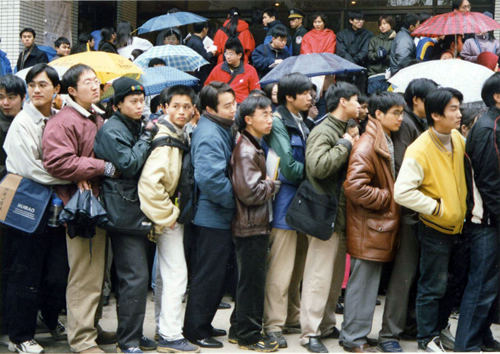|
 |
|
FOREIGN STUDY OBESSION: Students line up on a rainy morning in December 2001 to register for TOEFL test at Nanjing University (CFP) |
The introduction of the TOEFL (Test of English as a Foreign Language) exam in China in the early 1980s, an event largely overshadowed by the start of China's reform policies in 1978 but equally important to China's opening to the outside world, was the flame that sparked Chinese youths' obsessions to study overseas.
In May 1981, China's Ministry of Education signed a contract with the Educational Testing Service (ETS) of the United States, allowing the test to be held in China jointly by ETS and the Chinese Government.
Seven months later, the first TOEFL test was given in Beijing, Shanghai and Guangzhou, with only 161 students sitting the test. To date, more than 3 million Chinese students have taken the test, the first steps in their adventures in education overseas.
TOEFL is the premise for Chinese students' foreign study dream. Getting a good TOEFL score has a huge impact on whether they are able to get admission to their universities of choice. Also, since more Chinese students choose to study abroad, a whole industry—English training—has risen up with countless companies that try to help students prepare to study overseas or take the test.
Recognized by more than 8,000 institutions in more than 130 countries, TOEFL is one of the most widely accepted English language assessments in China, available at more than 200 sites across the country.
TOEFL test takers increased by 19 percent year on year in China in 2011, reaching a record high, according to the ETS in February 2012.
Over the past three decades, the social background of students taking the exam has changed. In the 1980s when the test was first launched in China, most students sitting the exam had government support or were visiting scholars. After the 1990s, the number of self-funded overseas students soared alongside the deeper reform and opening up in China.
Now, most TOEFL examinees are self-funded students with an eye on overseas education. Aside from learning an international language, students also have a competitive edge in job hunts in the domestic market thanks to their overseas experiences.
TOEFL has changed over the years. The earliest TOEFL test consisted of three parts: reading, listening and grammar, which required students to write their answers on paper. In the late 1980s, due to rising demand in communication, written and spoken English were added as optional choices. In 2005, the TOEFL Internet-based test was created, and was revised in 2006.
TOEFL's rapid expansion in China is to a great extent attributed to the flourishing of foreign study in China, now one of the world's largest countries sending students abroad.
Ever since the implementation of the reform and opening up policy, there have been 1.9 million Chinese students studying overseas and the number for the year 2010 was nearly 300,000. Most students have taken the test before going to English-speaking countries for further study.
"Foreign study boomed in China for many reasons," said Zhang Xiuqing, Director General of the Department of International Cooperation and Exchange of the Ministry of Education. "One of the most important reasons is the constant support from the Chinese Government. In the future, more students from China, both government-sponsored ones and self-funded ones, will study abroad."
During the past three decades, China's English education and testing have made substantial progress.
"The introduction of TOEFL has not only propelled the development of China's English language teaching but also offered a reference for China's examination reform," said Jiang Gang, Director General of the National Education Examinations Authority. After the first TOEFL test in 1981, the English test in China's college entrance examination started reform in 1985, adopting many of TOEFL's experiences. Also, domestic English tests—College English Band 4 and Band 6—have been deeply influenced by TOEFL."
A brand new industry—English training—emerged in China after the first TOEFL test in 1981. Almost over night, a large number of English training agencies appeared. At present, well-known English training institutions in China include New Oriental, EF Education, Wall Street English, Hiknow and Web International English.
| 